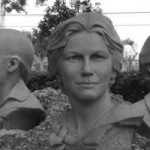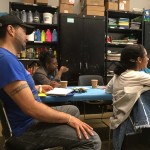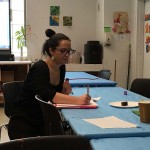This past Saturday, May 14th, we had a very special class. Our students were granted the opportunity to present any art or artist of their choice during our class time. The idea was to employ the knowledge about art and English skills they have gained during the past weeks of our workshop leading to a variety of insightful presentations. Our first presentation was on “Music as Cultural Identity”, and so the student presented her favorite famous quotes about music, among them:

As a class we took the opportunity to collectively translate these quotes for those who did not fully understand them. As the presentation continued the student revealed her thoughts on music, stating: “I think all people are music; music helps us establish a connection and just by listening to music you can know people’s views.” She then provided an example by reading the lyrics to Pink’s song, Dear Mr. President, in which the artist expresses her frustration with the infamous Bush administration. This was a great way to connect her presentation with one of the principal themes of our workshop: art is born out of human frustrations (and often highlighting how that happens). She also read the lyrics of John Lennon’s iconic song, Imagine, which provoked an interesting class discussion about how we as immigrants feel about the impossibility of imagining a world that offers us the possibility of being one; it was a very touching moment.
We then moved on to another presentation, this time by a student who presented on the Mirabal sisters, who were — and remain — symbols of political and feminist resistance. One of the sisters, Patricia Mirabal was considered a talented painter; her art depicted the intimate ‘sweet and tragic moments’ of her life. Ultimately, the sisters were murdered by the Trujillo administration, the dictatorial government they were so vehemently opposed to. Our student spoke of the sisters’ courage because they admittedly accepted the possibility of death if it meant they could defend their ideals against Trujillo’s reign over the Dominican Republic. Since their death in 1960, many writers and artists have told and commemorated the Mirabal sisters’ legacy, creating a socio-historical mark through art.

 Sculptures honoring the Mirabal sisters.
Sculptures honoring the Mirabal sisters.
Our next presentation was on renowned Colombian painter, sculptor, caricaturist and plastic artist, Omar Rayo. Our student spoke about Rayo’s greatest inspirations — nature and geometry — and how on his first visit to New York City he was shocked by all the pollution that he witnessed. This led him to paint only in black and white when depicting New York, while using other colors when inspired by other countries.


This presentation allowed us to draw a parallel between Duke Reily’s mural That’s What She Said, which we studied a few weeks ago, and Rayo’s work, as both artists’ productions are greatly influenced by the effects of contamination, attempting to create an awareness against pollution through their art.
Our final presentation was on Tejada’s Cats, formally known as El Gato del Rio, by Colombian painter and sculptor Hernando Tejada. He donated this sculpture with the intention of beautifying and enriching the Riviera of El Rio Cali, the city’s principal river, which streams through the city of Cali, Colombia.
 El Gato del Río y Las Novias del Gato
El Gato del Río y Las Novias del Gato
Our student explained how this sculpture became the cultural pride of many Caleños — natives of Cali — and 10 years after its installation the city decided to grant this monumental — but lonely — cat some company. Our student described how this was accomplished by inviting 15 renowned Colombian plastic artists to each create a girlfriend, a smaller sculpture of a feminine feline, to install around El Gato del Rio. It was then that the student who had presented on Omar Rayo informed the class that Mr. Rayo had actually created one of the 15 feline girlfriends of Tejada’s cat, revealing this picture:
 Omar Rayo’s contribution to The Girlfriends of the Cat.
Omar Rayo’s contribution to The Girlfriends of the Cat.
This revelation led to a conversation about how artists collaborate among themselves and helped us make an important parallel to the collaboration that took place when Louis C. Tiffany — the American artist and designer who created fantastic leaded glass collection — “staffed his studios with a corps of talented chemists, designers, and artisans who worked together to realize his artistic vision and keep pace with the demand for his leaded-glass objects.” As our students had learned during previous classes, The Neustadt Collection of Tiffany Glass, on long-term view at the Queens Museum, was a collaborative effort.
Our students’ expositions were mostly presented in English, the students only resorted to using Spanish when necessary. As a class we not only learned about artists who were formerly unknown to some of us, but we were also able to make meaningful connections between present and past class material.
To close our class, the students were given a lesson on the Past Simple Tense since we are constantly discussing and learning about artists that are no longer with us; additionally, of course, everybody’s yesterday is always in the past.

 New New Yorkers
New New Yorkers





